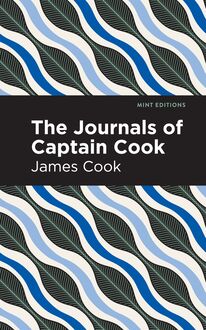-
 Univers
Univers
-
 Ebooks
Ebooks
-
 Livres audio
Livres audio
-
 Presse
Presse
-
 Podcasts
Podcasts
-
 BD
BD
-
 Documents
Documents
-
- Cours
- Révisions
- Ressources pédagogiques
- Sciences de l’éducation
- Manuels scolaires
- Langues
- Travaux de classe
- Annales de BEP
- Etudes supérieures
- Maternelle et primaire
- Fiches de lecture
- Orientation scolaire
- Méthodologie
- Corrigés de devoir
- Annales d’examens et concours
- Annales du bac
- Annales du brevet
- Rapports de stage
La lecture à portée de main
Vous pourrez modifier la taille du texte de cet ouvrage
Découvre YouScribe en t'inscrivant gratuitement
Je m'inscrisDécouvre YouScribe en t'inscrivant gratuitement
Je m'inscrisEn savoir plus
Vous pourrez modifier la taille du texte de cet ouvrage
En savoir plus

Description
Depicted by the man himself, The Journals of James Cook is an intimate first-hand account, providing an uncensored and reliable narrative of adventures spanning across the globe. The Journals of James Cook depict three of Captain James Cook’s most glorious expeditions, starting in 1768 and leading to Cook’s tragic death in 1779. Having ventured all over the Pacific, Cook encountered lands not yet charted by the British. Though his discoveries and maps inadvertently led to British colonization, Cook held a deep respect for the native people he encountered. He recorded their practices and wrote of them fondly. Cook even befriended some of the native people he encountered, including a Tahitian man who, after hearing of Cook’s homeland, wanted to visit it as well. Per the man’s request, Cook sailed him to Britain, where the man stayed until he and Cook sailed back to Tahiti three years later. After charting Australia, and the whole coast of New Zealand, Cook was involved in a plot to kidnap a Hawaiian monarch and ransom them in order to recover stolen property. He was killed during this expedition, leaving behind a legacy of a detailed description of the Pacific Ocean and its coasts.
James Cook’s expeditions around the world and his detailed and innovative work as a cartographer inspired advancements in scientific, medical, historical and geological fields. His influence has also reached the literary world, inspiring novel series and characters, including the infamous Captain Hook. Exuding ambition, courage, and confidence, The Journals of James Cook provide a privileged peak into the travels and accomplishments of an adventurous, and invaluable man. Packed with wonder but free of imperialistic arrogance, The Journals of James Cook serve as a valuable an intriguing primary source of a time when places in the world were yet to be mapped.
Now presented in an easy-to-read font and redesigned with a stunning new cover, James Cook’ The Journals of James Cook is accommodating to contemporary readers, providing a fresh version of the esteemed literary work while preserving its wonders and adventures.
Sujets
Informations
| Publié par | Mint Editions |
| Date de parution | 08 décembre 2020 |
| Nombre de lectures | 0 |
| EAN13 | 9781513274447 |
| Langue | English |
| Poids de l'ouvrage | 1 Mo |
Informations légales : prix de location à la page 0,0600€. Cette information est donnée uniquement à titre indicatif conformément à la législation en vigueur.
Extrait
The Journals of Captain Cook
James Cook
This title was originally published as Captain Cook’s Journal During the First Voyage Round the World in 1893.
This edition published by Mint Editions 2021.
ISBN 9781513269443 | E-ISBN 9781513274447
Published by Mint Editions ®
minteditionbooks.com
Publishing Director: Jennifer Newens
Design & Production: Rachel Lopez Metzger
Typesetting: Westchester Publishing Services
C ONTENTS S KETCH OF C APTAIN C OOK ’ S L IFE P ERSONS WHO LEFT E NGLAND IN H.M.S. E NDEAVOUR , 26 TH A UGUST , 1768 1. E NGLAND TO R IO J ANEIRO 2. R IO J ANEIRO TO T AHITI 3. T AHITI 4. T AHITI TO N EW Z EALAND 5. E XPLORATION OF N ORTH I SLAND OF N EW Z EALAND 6. E XPLORATION OF M IDDLE I SLAND OF N EW Z EALAND 7. P ASSAGE FROM N EW Z EALAND TO N EW H OLLAND 8. E XPLORATION OF E AST C OAST OF A USTRALIA 9. F ROM T ORRES S TRAIT TO B ATAVIA 10. B ATAVIA TO C APE OF G OOD H OPE 11. C APE OF G OOD H OPE TO E NGLAND P OSTCRIPT
S KETCH OF C APTAIN C OOK ’ S L IFE
Captain Cook’s life, or the account of so much of it as is recoverable, has been so often recounted that there is no occasion to insert more in this publication than is necessary as a reference to the reader, to enable him to realise the career and character of the man.
Cook’s first biographer, Andrew Kippis, wrote in 1788, and his work has recently been republished. 1
The latest and best life is by Walter Besant, 2 whose graceful pen has given us a fascinating, interesting, and, as far as is possible, complete picture of this great Englishman. Many details of Cook’s private life are lost, but enough has been collected by Mr. Besant to place our hero vividly before us, and a perusal of his work is strongly recommended.
Many things in the following sketch are taken from Mr. Besant, to whom I wish to tender my acknowledgments.
James Cook rose from nearly the lowest ranks. The second son of James Cook, a Yorkshire labourer, and Grace his wife, he was born on the edge of the Cleveland Hills on February 27th, 1728, in the little village of Marton, which lies about four miles south-south-east of Middlesborough, and five miles west of the well-known hill and landmark, Roseberry Topping. Eight years later his father removed to Great Ayton, which lies close under Roseberry Topping.
At the age of thirteen Cook, who, it is recorded, had had some elementary schooling both at Marton and Great Ayton, was apprenticed to one Sanderson, a draper and grocer of Staithes, a fishing village on the coast, about fourteen miles from Ayton and nine north-west of Whitby.
A year later Cook went, or ran away, to sea, shipping at Whitby on board the Freelove, a collier belonging to the brothers Walker.
In this hard school Cook learnt his sailor duties. No better training could have been found for his future responsibilities. Here he learnt to endure the utmost rigours of the sea. Constant fighting with North Sea gales, bad food, and cramped accommodation, taught him to regard with the indifference that afterwards distinguished him, all the hardships that he had to encounter, and led him to endure and persevere where others, less determined or more easily daunted by difficulties, would have hurried on, and left their work incomplete.
All details of Cook’s life during his thirteen years in the merchant service are lost: what voyages he made, how he fared, whether he advanced in general knowledge, all is gone. The only fact known is that in May 1755, when Cook was twenty-seven years of age, and mate of a vessel of Messrs. Walker, then in the Thames, he, to avoid the press, then active on account of the outbreak of the war with France, volunteered on board H.M.S. Eagle, of 60 guns, as an able seaman.
Captain Hugh Palliser, who succeeded to the command of this ship in October, was certainly Cook’s warmest patron, and it would appear that Cook did work superior to that of an able seaman in the Eagle. Be that as it may, all that is absolutely known is that that ship took her share of the fighting at the taking of Louisbourg and elsewhere on the North American and West Indian Station, and returned to England in 1759.
By Palliser’s interest Cook was now appointed master of the Mercury. It is therefore evident that his qualifications as a navigator recommended themselves to Palliser.
The Mercury went to North America, and here Cook did his first good service recorded, namely, taking soundings in the St. Lawrence, to enable the fleet then attacking Quebec to take up safe positions in covering the army under Wolfe. This he accomplished with great skill, under many difficulties, in the face of the enemy, much of it being done at night. He was immediately employed in making a survey of the intricate channels of the river below Quebec, and for many years his chart was the guide for navigation. Cook was indeed a born surveyor. Before his day charts were of the crudest description, and he must have somehow acquired a considerable knowledge of trigonometry, and possessed an intuitive faculty for practically applying it, to enable him to originate, as it may truly be said he did, the art of modern marine surveying.
The expedition to Quebec concluded, Cook was appointed master of the Northumberland, bearing Admiral Lord Colville’s flag, and during that ship’s winter at Halifax he applied himself to further study of mathematics and astronomy.
In 1762, the Northumberland being at Newfoundland during the capture of that island from the French, Cook again was employed in surveys. This attracted the attention of Captain Graves, the Governor, who conceived a high opinion of his abilities in this respect.
In the latter part of 1762 Cook returned to England and married Elizabeth Batts, daughter of a man in business at Wapping; but a few months afterwards he was called upon by Captain Graves to go again to Newfoundland to make marine surveys.
In this important work he was engaged until 1767, Captain Palliser, who succeeded Captain Graves as Governor, being only too glad to avail himself of Cook’s services.
The charts he made during these years in the schooner Grenville were admirable. The best proof of their excellence is that they are not yet wholly superseded by the more detailed surveys of modern times. Like all first surveys of a practically unknown shore, and especially when that shore abounds in rocks and shoals, and is much indented with bays and creeks, they are imperfect, in the sense of having many omissions; but when the amount of the ground covered, and the impediments of fogs and bad weather on that coast is considered, and that Cook had at the most only one assistant, their accuracy is truly astonishing. The originals of these surveys form part of the most precious possessions of the Hydrographic Office of the Admiralty.
We now approach the crowning achievements of Cook’s life.
After many years’ neglect the exploration of the Pacific was awaking interest. This great ocean, which very few, even to this day, realise occupies nearly one half of the surface of the globe, had been, since the first voyage of Magellan, crossed by many a vessel.
Notwithstanding, very little was known of the islands occupying its central portion.
For this there were two reasons. First, the comparatively small area covered by islands; secondly, the fact that nearly all who traversed it had followed Magellan’s track, or, if they started, as many did, from Central America, they made straight for Magellan’s discovery, the Ladrone Islands. For this, again, there was a reason.
Few sailed for the purpose of exploration pure and simple; and even those who started with that view found, when embarked on that vast expanse, that prudence dictated that they should have a moderate certainty of, by a certain time, falling in with a place of sure refreshment. The provisions they carried were bad at starting, and by the time they had fought their way through the Straits of Magellan were already worse; water was limited, and would not hold out more than a given number of days. Every voyage that is pursued tells the same story—short of water, and eagerly looking out for an opportunity of replenishing it. The winds were found to blow in fixed directions, and each voyager was fearful of deviating from the track on which it was known they would be fair, for fear of delays. And ever present in each captain’s mind was the dread of the terrible scourge, scurvy. Every expedition suffered from it. Each hoped they would be exempt, and each in turn was reduced to impotence from its effects.
It was the great consideration for every leader of a protracted expedition, How can I obviate this paralyzing influence? And one after another had to confess his failure.
It is yearly becoming more difficult for us to realise these obstacles.
The prevailing winds and currents in each part of the ocean are well known to us: the exact distance and bearing from one point to another are laid down in the chart; steam bridges over calm areas, and in many cases conducts us on our entire journey at a speed but little inferior to that of land travelling by railroad; modern science preserves fresh and palatable food for an indefinite period; and, in a word, all the difficulties and most of the dangers of long voyages have disappeared.
Take one element alone in long voyages—the time required. The average progress of a ship in the eighteenth century was not more than fifty miles a day. Nowadays we may expect as much as four hundred miles in a full powered steamer, and not less than one hundred and fifty in a well-fitted sailing ship.
But navigation, and more especially the navigation of the unknown Pacific, was very different in Cook’s days, when all the obstacles above mentioned impeded the explorers, and impelled them to follow a common track.
There were a few who had deviated from the common track.
The Spaniards, Mendana, Quiros, Torres, in the latter part of the sixteenth century, starting first from th
-
 Univers
Univers
-
 Ebooks
Ebooks
-
 Livres audio
Livres audio
-
 Presse
Presse
-
 Podcasts
Podcasts
-
 BD
BD
-
 Documents
Documents
-
Jeunesse
-
Littérature
-
Ressources professionnelles
-
Santé et bien-être
-
Savoirs
-
Education
-
Loisirs et hobbies
-
Art, musique et cinéma
-
Actualité et débat de société
-
Jeunesse
-
Littérature
-
Ressources professionnelles
-
Santé et bien-être
-
Savoirs
-
Education
-
Loisirs et hobbies
-
Art, musique et cinéma
-
Actualité et débat de société
-
Actualités
-
Lifestyle
-
Presse jeunesse
-
Presse professionnelle
-
Pratique
-
Presse sportive
-
Presse internationale
-
Culture & Médias
-
Action et Aventures
-
Science-fiction et Fantasy
-
Société
-
Jeunesse
-
Littérature
-
Ressources professionnelles
-
Santé et bien-être
-
Savoirs
-
Education
-
Loisirs et hobbies
-
Art, musique et cinéma
-
Actualité et débat de société
- Cours
- Révisions
- Ressources pédagogiques
- Sciences de l’éducation
- Manuels scolaires
- Langues
- Travaux de classe
- Annales de BEP
- Etudes supérieures
- Maternelle et primaire
- Fiches de lecture
- Orientation scolaire
- Méthodologie
- Corrigés de devoir
- Annales d’examens et concours
- Annales du bac
- Annales du brevet
- Rapports de stage




















